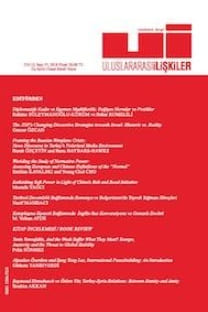Askeri Güvenliğin Değişen Gündemi
Güvenlikleştirme, bir şeyin değerli kabul edilen bir öznenin varlığına yönelik bir tehdit olarak inşa edilmesi ve buna mukabil alınan istisnai tedbirleri desteklemek için kullanılmasıdır. Güvenlik dışılaştırma ise, daha önce tehdit olduğu kabul edilen bir şeyin artık tehdit olarak inşa edilmemesidir. Makale, askeri sektördeki güvenlikleştirmenin temel eğilimlerinde yaşanan değişimleri dört farklı dönem çerçevesinde incelemektedir: 1945’te biten klasik Avrupa büyük güç dönemi, Soğuk Savaş, Soğuk Savaş sonarsı dönem ve 11 Eylül 2001 sonrası. 11 Eylül sonrası dönemde, güvenlikleştirmenin klasik devlet merkezli çerçevesinden daha farklı aktörlerin ve referans konularının yer aldığı bir askeri güvenlik gündemine doğru değiştiği görülmektedir. Güvenlikleştirmenin bu çerçevesinin sürekliliğini değerlendirmek için çok erken olsa da, bunun önceki dönemlerden keskin bir şekilde farklılaştığı ve daha fazla şiddet yapısı içerdiği kesindir.
Anahtar Kelimeler:
Güvenlikleştirme, Güvenlik Dışılaştırma, Askeri Sektör, Teröre Karşı Savaş, Güvenlikleştirmenin Küreselleştirilmesi
The Changing Agenda of Military Security
Securitization is the construction of something as an existential threat to a valued referent object, which is used to support exceptional measures taken in response. Desecuritization occurs when something previously accepted as a threat is no longer constructed as one. The article examines the changes in the main patterns of securitization in the military sector across four distinct periods: the classical European great power era ending in 1945, the Cold War, the post-Cold War period, and post-September 11 2001. In the post-September 11 period, it is seen that securitization moved away from classical, state-centric framework of securitization and towards one with much more mixed set of actors and referent objects. Though its is too early to assess the durability of this framework of securitization, it is certain that it differs starkly from the previous periods and involves more structures of violence
Keywords:
Securitization, Desecuritization, Military Sector, War of Terror, Globalization of Securitization,
- ISSN: 1304-7310
- Başlangıç: 2004
- Yayıncı: Uluslararası İlişkiler Konseyi Derneği İktisadi İşletmesi
Sayıdaki Diğer Makaleler
Teori ve Pratikte Güvenliğin Bölgeselleşmesi
Askeri Güvenliğin Değişen Gündemi
Güvenliğin Yeniden Kavramsallaştırılması: Barış, Güvenlik, Kalkınma ve Çevre Kavramsal Dörtlüsü
Güvenlik ve Çevre Bağlantılarına Yeniden Bakmak
İslam Örneğinde Küreselleşen Dünyada Kimliğe Dayalı Güvenlik Tehditleri
Toplumsal Güvenliğin Değişen Gündemi
Uluslararası İlişkilerde Güvenlik Kavramı
Latin Amerika’da Barış Üzerine Doğulu, Avrupalı ve Yerli Düşünce
